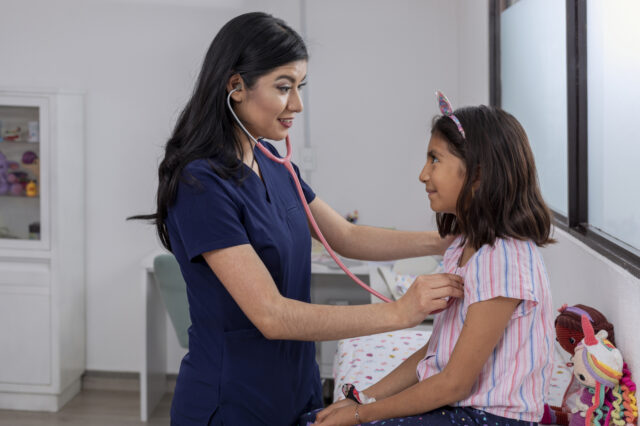Australian Asthma Handbook
The National Guidelines for Health Professionals
Cite
Table
| Situation | Total dose per occasion | Administration |
| Cough or wheeze without visibly increased work of breathing |
2–4 actuations x salbutamol 100 microg/actuation If symptoms do not resolve within a few minutes, give 2–4 more actuations. |
With spacer: Add 1 actuation to spacer – child takes 4 breaths in and out of spacer. Immediately repeat for second and subsequent actuations until the recommended number of actuations have been given. |
| Symptoms with increased work of breathing |
12 actuations x salbutamol 100 microg/actuation If symptoms do not resolve within a few minutes, give 12 more actuations and call 000 for an ambulance. If symptoms still do not resolve, or recur within 3 hours, parents/carer should take child to ED or call 000 for an ambulance. |
Table
| Active ingredient | Total daily dose (microg) | ||
Low | Medium | High | |
| Fluticasone propionate | 100 (50 twice daily) | <8 years: >100–200 (e.g. 100 twice daily) | <8 years: >200 |
8–11 years: >100–250 (e.g. 100 twice daily or 125 twice daily) | 8–11 years: >250 | ||
| Ciclesonide | 80 | 160 | >160 |
| Budesonide | 100–200 | >200–400 | >400 |
| Beclometasone (extra-fine particle) | 50–100 | >100–200 | >200 |
Additional information
ICS: inhaled corticosteroid
[ ] Options recommended for first-line use in children, based on current evidence for efficacy and safety
Options not recommended as first-line treatment in children due to delivery device or concerns about systemic effects including potentially greater effects on growth
Provide clear instructions to parents/carers about salbutamol doses when symptoms do not rapidly resolve or recur within hours.
Educate parents on how to recognise an asthma emergency.
Ensure the child’s asthma action plan is kept up to date.
Recommendation type: Consensus recommendation
Information on assessing and managing acute asthma in primary care or emergency departments
Recommendation type: Consensus recommendation
For children not taking regular ICS treatment (ICS or ICS-LABA), do not prescribe short-term high-dose ICS to manage worsening asthma symptoms or as part of a written asthma action plan.
For children treated with maintenance low-dose ICS, do not prescribe short-term high-dose ICS to manage worsening asthma symptoms or as part of a written asthma action plan.
Recommendation type: Consensus recommendation
Short-term increases in ICS dose, including the use of high doses given at the onset of increasing asthma symptoms, are not effective for preventing exacerbations necessitating treatment with systemic corticosteroids in children aged 6–11 years.[Jackson 2018]
Limited (low-quality) evidence from clinical trials suggests that short courses of high-dose ICS is well tolerated in children younger than 6 years.[Fernandes 2019]
Jackson DJ, Bacharier LB, Mauger DT, et al. Quintupling inhaled glucocorticoids to prevent childhood asthma exacerbations. N Engl J Med 2018; 378: 891-901.
Fernandes RM, Wingert A, Vandermeer B, et al. Safety of corticosteroids in young children with acute respiratory conditions: a systematic review and meta-analysis. BMJ Open 2019; 9: e028511.
Some action plan templates reflect the recommendation of some guidelines to increase ICS dose at the onset of worsening symptoms.
If SABA reliever is needed again within 4 hours, or symptoms are recurring or worsening over a day, consider prescribing a short course of systemic corticosteroids: 1 mg/kg prednisone/prednisolone (maximum 50 mg) each morning for up to 3 days.
Advise parents about common side-effects, including sleep disturbance, increased appetite, reflux, and mood changes.
Recommendation type: Adapted from GINA
Global Initiative for Asthma (GINA). Global Strategy for Asthma Management and Prevention, 2025. Available from: www.ginasthma.org
To discourage overuse, prescribers should avoid supplying parents with more prednisone/prednisolone than needed for the course. Prescribers may write PBS scripts for less than the maximum quantity and number of repeats permitted if a lesser quantity is sufficient for the patient’s requirements.
For children aged 6–11 years, do not routinely instruct parents/carers to start a course of oral corticosteroids at their own discretion.
Do not routinely prescribe or recommend oral corticosteroids to be started at home as part of the child’s written asthma action plan.
When writing scripts for oral corticosteroids, do not allow repeats.
Recommendation type: Consensus recommendation
Victoria: Victorian Virtual Emergency Department
NSW: virtualKIDS Urgent Care Service via Healthdirect 1800 022 222
Queensland: Virtual Emergency Care Service - Queensland Virtual Hospital
Prescribers should avoid supplying parents with more prednisone/prednisolone than needed for the course. Prescribers may write PBS scripts for less than the maximum quantity and number of repeats permitted if a lesser quantity is sufficient for the patient’s requirements.
Instruct parents to contact a health professional before starting a course of oral corticosteroid for their child. If the child’s GP or usual asthma clinician is unavailable, parents should contact the online or phone urgent care service in their state or territory.
Some asthma action plan templates include a checkbox for oral corticosteroid with typical dosing instructions. Strike out these instructions to avoid misunderstanding.
For children with severe asthma managed in specialist care, clinicians might instruct parents when to start oral corticosteroids.
Provide clear instructions on the child’s written asthma action plan on who to call for advice before starting.
Instruct parents to report if oral corticosteroids are used.
When writing scripts for oral corticosteroids, do not allow repeats.
Consensus recommendation

Children 6-11 years
How to conduct a rapid assessment and administer bronchodilators and supplementary oxygen to patients aged 6–11 years…

Children 6-11 years
Recommendations for acute care facilities on rapid assessment, bronchodilators, supplementary oxygen and follow-up for…

Medication management
How to investigate asthma that is not well controlled despite treatment with medium-dose ICS-LABA.